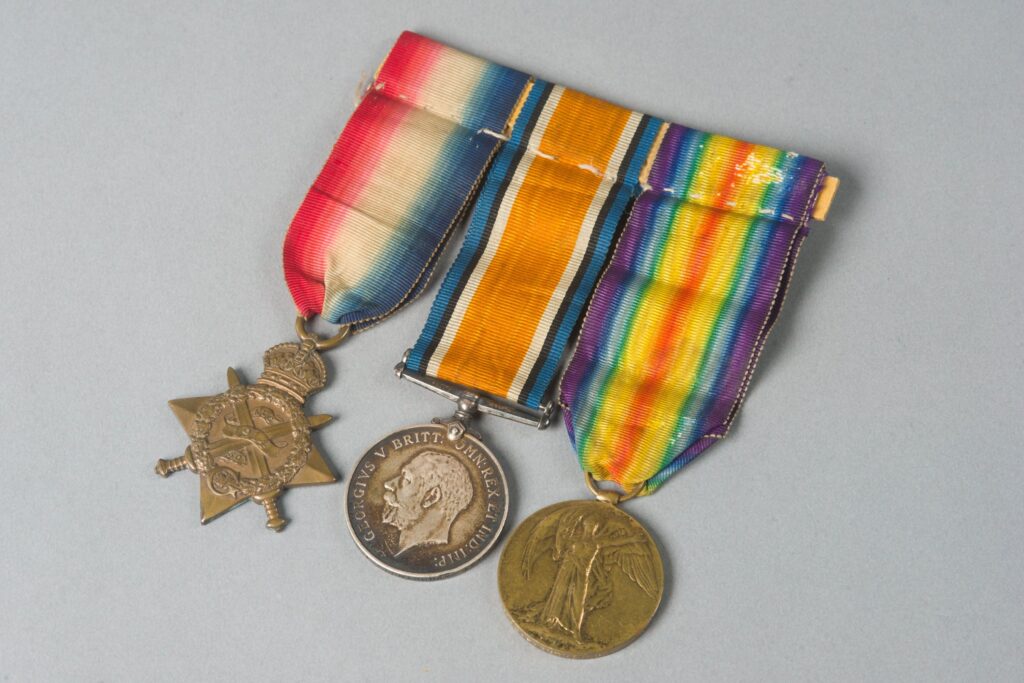Explore
Medals on suspension bar
Three First World War medals, the 1914 Cross, British War, and Victory medal, attached to home-made cardboard bar, each medal inscribed with name of Pte. W.F. Cunningham of the Leinster Regiment

Three medals, the 1914 Star, British War and Victory medal, attached to home-made cardboard bar by sewn loop, each medal inscribed with name of Pte. W.F. Cunningham of the Leinster Regiment. The 1914 Victory Star comprises a lacquered bronze star, the uppermost star taking the form of the imperial crown. A pair of crossed swords (topped by an oak leaf) features on the obverse of the medal. An inscription upon the star bears the legend Aug-Nov 1914. The reverse of the medal carries the recipient’s number, rank, name and unit as follows “7346/PTE. W.F. CUNNINGHAM./LEINS: R.” The medal is attached by a circular suspension loop to a ribbon with the red white and blue colours of the Empire, in shaded and watered stripes.. The British War medal comprises a cupro-nickel disc with the effigy of George V on the obverse. The reverse has an image of St George on horseback trampling underfoot the eagle shield of the Central Powers, and a skull and cross-bones, the emblems of death. Above this is the risen sun of victory. The years 1914 and 1918 are contained on the outside edge medal. Around the rim of the medal is the recipients number, rank, name and unit as follows “7346 PTE. W.F. CUNNINGHAM. LEINS: R”. The medal is attached to the ribbon by a suspension bar, the ribbon has a wide central watered stripe of orange, flanked by two narrow white stripes, which are in turn flanked by two black pin-stripes, further flanked by two outer stripes of purple. The Victory Medal is comprised of a bronze disc with a winged figure of Victory on the obverse. The reverse has the words ‘THE GREAT WAR FOR CIVILISATION’, all surrounded by a laurel wreath. The recipient’s number, rank, name and unit are inscribed around the rim of the medal as follows: “7346 PTE. W.F. CUNNINGHAM. LEINS: R”.
Private William Cunningham was the son of John and Margaret Cunningham from the Turnpike in Ennis, County Clare. He was married and a pre-war professional soldier based in Cork with the 2nd Battalion, Leinster Regiment at the outbreak of the war, arriving at St Nazaire, France on 12th September 1914.
Private Cunningham was listed among the Missing in Action, later changed to presumed Killed In Action, in Belgium on 20 October 1914. He has no known grave. His battalion had been involved in some very heavy fighting in and around Armentiere and an entry in the battalion war diary on the 23 October 1914 puts his battalions casualties from the 18 October – five days – at 434 with 155 killed.
The Battle of Armentiere (13 October – 22 November 1914) was one of several battles in the Ypres sector which became known as the First Battle of Ypres (12 November – 22 October 1914). Private Cunningham is remembered on the Ploegsteert Memorial in the Berks Cemetery Extension, Belgium
The uncle of the donor married Patrick Cunninghams daughter and the donor inherited both medals. Initially the medals were loaned to the museum for an exhibition to mark the 90th anniversary of the Armistice in 2008, but were subsequently donated.
Tragically for the Cunningham family, William’s younger brother Lance Sergeant John Cunningham, aged 25, 2nd Battalion, Royal Munster Fusiliers was killed in action at Rue-de Bois on 9th May 1915 at the Battle of Aubers Ridge. He also has no known grave and is remembered at the Le Touret Memorial, Fance.
Reference: secondary ref to 2nd bn, Leinster Regiment’s war diary.
Collection: Frances Morrissey
Category: Medallion/Badge